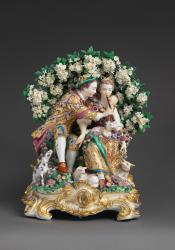Chelsea Porcelain Factory
16 Lawrence Street was the home of the Chelsea China factory from 1745 to 1784, until the business was sold off and moved elsewhere. At the time, the area was a highly fashionable suburb to live in, so the factory had plenty of customers to purchase their fine goods. This fashionable air to the area continues until today, and the wealth of the area is still felt. The creation of this factory is due in part to the large French population in the area, which is an aspect of the borough that is still noted today. Many immigrants would continue in their original occupations, but for the two men that founded the factory, they adopted a different industry that still related to their artistic and business backgrounds. A plaque was placed in 1950 to mark that production took place at the north end of Lawrence Street, and it is also noted that the novelist Tobias Smollett lived in the building from 1750 to 1762.
“Chelsea Porcelain Manufactory: Finch: British, Chelsea.” The Metropolitan Museum of Art, https://www.metmuseum.org/art/collection/search/658952. Accessed 18 April 2023.
“Chelsea Porcelain Manufactory: The Music Lesson: British, Chelsea.” The Metropolitan Museum of Art, https://www.metmuseum.org/art/collection/search/203386. Accessed 18 April 2023.
“Chelsea Porcelain.” Encyclopædia Britannica, Encyclopædia Britannica, Inc., https://www.britannica.com/art/Chelsea-porcelain. Accessed 18 April 2023.
“Collections Online: British Museum.” Collections Online | British Museum, https://www.britishmuseum.org/collection/term/BIOG67142. Accessed 18 April 2023.
A History of the French in London. Edited by Debra Kelly and Martyn Cornick, School of Advanced Study, 2013, https://sas-space.sas.ac.uk/6460/1/FrenchLondonKellyCornick.pdf. Accessed 18 April 2023.
“Tobias Smollett: Novelist: Blue Plaques.” English Heritage, https://www.english-heritage.org.uk/visit/blue-plaques/chelsea-china/. Accessed 18 April 2023.
Coordinates
Longitude: -0.171089000000

